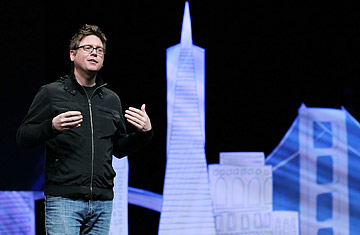
Twitter co-founder Biz Stone speaks during the first annual Chirp Twitter developer conference in San Francisco
Twitter tried to reintroduce itself during the company's first-ever developer conference Wednesday, making the case that it has grown beyond the precocious start-up phase by giving the best insight yet into the company's users, infrastructure — and plans to start actually making money.
The event, called Chirp (fitting with Twitter's bird theme), was the culmination of a weeklong press blitz of announcements. But for the first time, co-founder Biz Stone gave a peek behind the curtain at Twitter's growth over the past four years: the site now has some 106 million registered users (increasing by 300,000 each day), together posting 55 million new tweets every 24 hours.
So what's on Twitter's horizon? The big announcement came even before the developer conference, when Twitter announced it would allow companies to start placing sponsored tweets in Twitter search results. Just as Google provides contextual advertising, so too would Twitter: if Twitter users are searching for Justin Bieber en masse (as they do, incessantly), his record label could sponsor a tweet that would appear at the top of the search results.
Underwhelming? Sure. But it's the first time Twitter has addressed the revenue question at all. "We've been focused on scaling the technology and building the best product possible," co-founder Evan Williams said. "And we've had investors who have bought into that long-term vision."
Twitter also announced the option for users to start including real-world location data in their tweets. While Twitter previously allowed users to post the latitude and longitude of a tweet, users can now share their specific place à la Foursquare or Gowalla, the two location services that have caught on early in 2010. But Williams insisted Twitter wasn't going after these companies directly: "We're not looking to duplicate the functionality of [those] services ... We really care about the content of that place, not just where people are."
If that seems like a vague distinction, it's by design. Twitter has long viewed itself as a platform, releasing tools and letting third parties come up with the uses for them. "Twitter in a lot of ways has taught us what it wants us to be," co-founder Stone said. That's in sharp contrast to a company like Apple, which regulates developers heavily to make sure the technology precisely matches Steve Jobs' vision.
The consequence, then, is that a Twitter event is decidedly less glamorous or exciting than an Apple reveal. Instead of announcing fully fledged products, Twitter announces ideas, leaving it to developers to figure out what to do with them. Geolocation and the ability for websites to better display tweets from the service in real time (also announced at Chirp) are great concepts. But it'll be third-party developers who come up with the killer application for them. Twitter may have reached adolescence, but the objectives remain much the same as they were before: find more users, and get them tweeting. If and when they have a fully formed way to turn a profit in the process, we'll know the company has really come of age.
